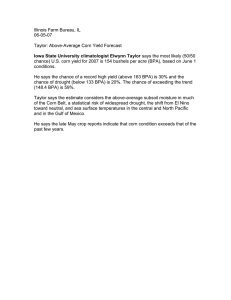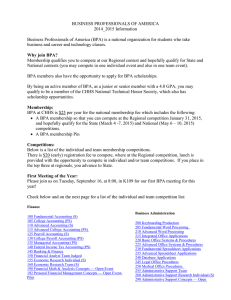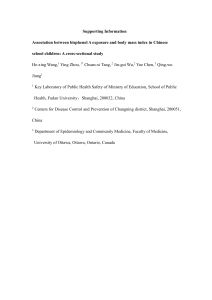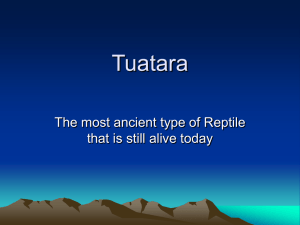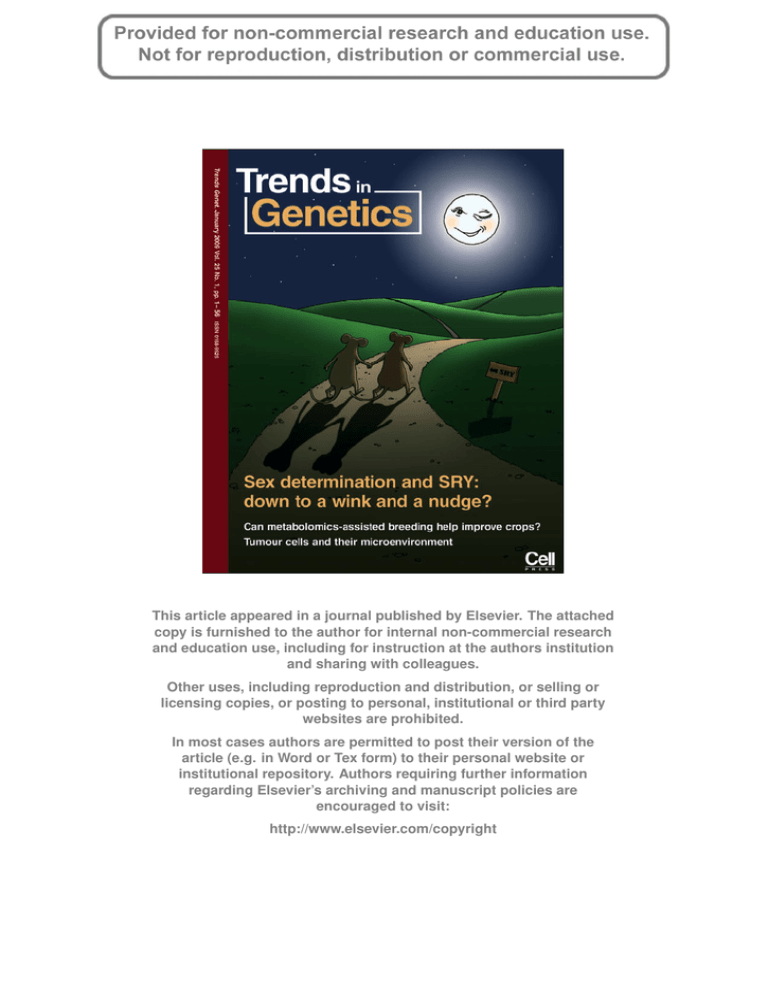
This article appeared in a journal published by Elsevier. The attached
copy is furnished to the author for internal non-commercial research
and education use, including for instruction at the authors institution
and sharing with colleagues.
Other uses, including reproduction and distribution, or selling or
licensing copies, or posting to personal, institutional or third party
websites are prohibited.
In most cases authors are permitted to post their version of the
article (e.g. in Word or Tex form) to their personal website or
institutional repository. Authors requiring further information
regarding Elsevier’s archiving and manuscript policies are
encouraged to visit:
http://www.elsevier.com/copyright
Author's personal copy
Update
The need for replication of results
Hunt et al. [5] previously reported that dosing mice with
20 mg BPA kg1 for seven days causes chromosome congression failure during oocyte meiosis [5], but – as with any
science – it is essential that the results can be independently
repeated. Subsequent to Hunt and Hassold’s [1] review,
three linked papers on BPA were published and in an
independent repeat of Hunt et al. [5], no effect was seen
on congression failure (hyperploidy) [10]. Paccheriotti et al.
[11] found that acute or chronic dosing of BPA to mice did not
induce hyperploidy or polyploidy in oocytes or zygotes, but
did see a significant increase of metaphase II oocytes with
prematurely separated chromatids after chronic (but not
acute) exposure to BPA. There were detrimental effects
when oocytes were incubated with doses >7 mg BPA L1
in vitro but there were also ‘non-linear dose-dependent
effects’ on meiosis II at lower doses [12]. A failure in replicability has blighted much of the low-dose BPA literature and
it is essential to determine which, if any, of these findings are
capable of independent replication.
Investigating environmental aneugens is important
and worthwhile science; however, the development and
deployment of robust, validated and relevant methods is a
prerequisite for determining the influence of environmental chemicals on human oogenesis.
Acknowledgements
D.R.B. is in receipt of grants from the Food Standards Agency and Dow
Chemical Company for research on dioxins and has not received funding
for research on BPA.
Trends in Genetics
Vol.25 No.1
2 Völkel, W. et al. (2002) Metabolism and kinetics of bisphenol A in
humans at low doses following oral administration. Chem. Res.
Toxicol. 15, 1281–1287
3 Dekant, W. and Voelkel, W. (2008) Human exposure to bisphenol A by
biomonitoring: methods, results and assessment of environmental
exposures. Toxicol. Appl. Pharmacol. 228, 114–134
4 Matthews, J.B. et al. (2001) In vitro and in vivo interactions of bisphenol
A and its metabolite, bisphenol A glucuronide, with estrogen receptors a
and b. Chem. Res. Toxicol. 14, 149–157
5 Hunt, P.A. et al. (2003) Bisphenol A exposure causes meiotic aneuploidy
in the female mouse. Curr. Biol. 13, 546–553
6 Tyl, R.W. et al. (2002) Three-generation reproductive toxicity study
of dietary bisphenol A in CD Sprague-Dawley rats. Toxicol. Sci. 68,
121–146
7 Morrisey, R.E. et al. (1987) The developmental toxicity of bisphenol A in
rats and mice. Fundam. Appl. Toxicol. 8, 571–582
8 Tyl, R.W. et al. (2008) Two-generation reproductive toxicity study of
dietary Bisphenol A (BPA) in CD-11 (Swiss) mice. Toxicol. Sci. 104,
362–384
9 EFSA (2006) Opinion of the Scientific Panel on Food Additives,
Flavourings, Processing Aids and Materials in Contact with Food
on a request from the Commission related to 2,2-BIS(4HYDROXYPHENYL)PROPANE (Bisphenol A). EFSA Journal 428,
1–75 (http://www.efsa.europa.eu/EFSA/Scientific_Opinion/afc_op_
ej428_bpa_op_en,1.pdf)
10 Eichenlaub Ritter, U. et al. (2008) Exposure of mouse oocytes to
bisphenol A causes meiotic arrest but not aneuploidy. Mutat. Res.
Genet. Toxicol. Environ. Mutagen. 651, 82–92
11 Pacchierotti, F. et al. (2008) Evaluation of aneugenic effects of
bisphenol A in somatic and germ cells of the mouse. Mutat. Res.
Genet. Toxicol. Environ. Mutagen. 651, 64–70
12 Lenie, S. et al. (2008) Continuous exposure to bisphenol A during
in vitro follicular development induces meiotic abnormalities. Mutat.
Res. Genet. Toxicol. Environ. Mutagen. 651, 71–81
References
1 Hunt, P.A. and Hassold, T.J. (2008) Human female meiosis: what makes
a good egg go bad? Trends Genet. 24, 86–93
0168-9525/$ – see front matter ß 2008 Elsevier Ltd. All rights reserved.
doi:10.1016/j.tig.2008.09.005 Available online 30 October 2008
Letters
The evolutionary rate of tuatara revisited
Hilary C. Miller1, Jennifer A. Moore1, Fred W. Allendorf1,2 and Charles H. Daugherty1
1
Allan Wilson Centre for Molecular Ecology and Evolution, School of Biological Sciences, Victoria University of Wellington,
P.O. Box 600, Wellington 6140, New Zealand
2
Division of Biological Sciences, University of Montana, 1440 Harrison Street, Missoula, MT 59802, USA
Often dubbed ‘living fossils’ (because they seem not to have
changed morphologically in >200 million years), tuatara
(Sphenodon punctatus and Sphenodon guntheri) are endemic New Zealand reptiles that are the only extant members of an archaic order of reptiles, which diverged from
squamates 250 million years ago. In a recent paper
published in Trends in Genetics, Hay and colleagues used
ancient DNA to examine the rate of molecular evolution in
tuatara and suggested that tuatara have the highest rate
of molecular evolution of any vertebrate studied to date [1].
We argue that the serially sampled dataset used by Hay
et al. [1] is not large enough to estimate an accurate rate of
Corresponding author: Moore, J.A. (Jennifer.Moore@vuw.ac.nz).
evolution and that their rate is likely to be an overestimate
because population structuring was not accounted for in
their analysis.
Hay et al. [1] concluded that the fast rate of evolution of
tuatara is contrary to many predictions about how substitution rates vary with life history traits (e.g. that substitution rates should be lower for ectothermic animals, and
those with low metabolic rates [2] or long generation times
[3]). The hypervariable region 1 (HVR1) substitution rate
for tuatara reported by Hay et al. [1] was 1.56 substitutions
per site per million years (ss1my1). However, the 95%
highest posterior density (HPD) intervals for this estimate
were broad (0.83–2.34 ss1my1) and overlapped considerably with those of Adelie penguins, aurochs and Mappin’s
13
Author's personal copy
Update
moa [1]. Thus, the conclusion of Hay et al. [1] that tuatara
have the highest rate of molecular evolution in vertebrates
is unjustified, because this conclusion is solely based on the
point estimate and ignores the associated 95% HPD. If the
evolutionary rate presented by Hay et al. [1] was converted
to a mutation rate by correcting for generation time (mean
generation time of tuatara is 40–50 years [4], or 20 000
generations my1), the estimated mutation rate would be
at least an order of magnitude greater than all other
published estimates based on heterochronous sequences
[5] (e.g. 7.65 105 ss1generation1 for tuatara, compared with 3.84 106 ss1generation1 for Adelie penguins). This estimate of mutation rate for tuatara is also
orders of magnitude higher than mutation rates estimated
from pedigrees and mutation accumulation lines [6] and is,
thus, implausibly high.
We suggest that the low variability of the dataset combined with the population history of tuatara have biased
the HVR1 substitution rate estimate of Hay et al. [1] For
heterochronous sequences to be useful in estimating the
rate of evolution, the population must be ‘measurably
evolving’ [7], that is, characterized by either a high
mutation rate or a wide range of sequence sampling times.
The tuatara dataset of Hay et al. [1] shows very little
sequence divergence (mean nucleotide diversity across
all samples = 1.9% 0.3) and contains only 33 ancient
samples. Although these ancient samples span dates
649–8748 years before present (BP), only three were
>4000 years old and the majority (22 out of 33) were
1000–3000 years old. When the analysis is re-run with
the dates on the ancient samples randomized (Figure 1),
Figure 1. Evolutionary rate estimates obtained when the dates on ancient samples
are randomized to destroy any signal obtained from nucleotide changes over time.
The dates on the ancient samples were randomized using an Excel macro and the
results of three randomizations are shown, along with the original rate. Bayesian
Markov-Chain Monte Carlo (MCMC) analyses implemented in the software
program Bayesian evolutionary analysis by sampling trees (BEAST; http://
beast.bio.ed.ac.uk/) [13], using the model and parameters reported by Hay et al.
[1] (general time reversible (GTR) + gamma (G) uncorrelated log-normal relaxed
clock) were used. Posterior distributions of parameters were sampled every 1000
cycles from the total MCMC chain length of 10 000 000, after discarding the initial
burn-in of 1 000 000 steps. This resulted in effective sample sizes >200 for all
sampled quantities. Analyses of the dataset using the original dates produced a
similar rate estimate in our hands to that reported by Hay et al. [1] (1.603 ss1my1;
95% HPD = 0.782–2.504).
14
Trends in Genetics Vol.25 No.1
the 95% HPD values for the randomized data overlap
considerably with those obtained using the original dates
and the point estimates for the randomized samples are
within the original 95% HPD interval. This indicates that
this dataset does not provide sufficient information about
the underlying rate of evolution.
A second confounding influence on the rate estimated
by Hay et al. [1] relates to the population history of
tuatara. The Bayesian methods used here assume no
population subdivision [7] and Hay et al. [1] used demographic models of either constant population size or exponential growth. None of these assumptions are valid for
tuatara over the timescale used by Hay et al. [1]. Tuatara
were once found throughout the main islands of New
Zealand and on many outlying offshore islands. Since
the arrival of humans and mammalian predators (730
years BP [8]), tuatara have experienced a severe population decline and range contraction. Modern natural
populations are now restricted to 32 small offshore
islands, which are highly genetically structured both between and within islands [9]. We have found that even
small breaks in habitat can result in considerable genetic
structuring [10], so it is highly unlikely that tuatara
have ever existed as a single panmictic population. This
structuring is also reflected in mitochondrial DNA
(mtDNA) sequences, because virtually every group of
islands has a unique set of mtDNA haplotypes and there
is a well-supported split between the northern and Cook
Strait islands ([11,12] and data from [1]). The ancient and
modern samples used by Hay et al. [1] were entirely
geographically distinct. Modern samples were taken from
offshore island populations, whereas ancient samples
were taken from mainland New Zealand. Given the level
of structuring between the offshore island populations, it
is reasonable to expect that a similar level of structuring
would be present between mainland and offshore island
sites, particularly given the historically small effective
population size of most island populations. To account
for the possible effect of geographic structuring between
ancient and modern samples, we reanalyzed the tuatara
dataset using only the ancient samples. The rate we
obtained was much lower than the rate of Hay et al.
[1], being 0.076 ss1my1 (95% HPD = 0.0016–0.32). We
suggest that ancestral population subdivision, unaccounted for by the model, has biased the rate upwards
and, thus, a portion of the ‘evolutionary rate’ estimated
for tuatara actually represents geographic differences
between ancient and modern samples, rather than
temporal differences.
Although Bayesian analyses of ancient DNA datasets
provide an exciting new method for estimating rates of
evolution, our analysis shows that the population history
of the species and the power of the dataset need to be
considered before substitution rate estimates should be
attempted. We suggest that Hay et al.’s [1] claim that
tuatara have the highest rate of molecular evolution in
vertebrates is open to debate and that accurate estimation of a rate of evolution for tuatara will require a
larger dataset from ancient samples and the ability to
incorporate population subdivision into the Bayesian
model.
Author's personal copy
Update
Acknowledgements
We thank Alexei Drummond, Peter Ritchie and Lara Shepherd for helpful
discussions and comments on the manuscript.
References
1 Hay, J.M. et al. (2008) Rapid molecular evolution in a living fossil.
Trends Genet. 24, 106–109
2 Gillooly, J.F. et al. (2005) The rate of DNA evolution: effects of body size
and temperature on the molecular clock. Proc. Natl. Acad. Sci. U. S. A.
102, 140–145
3 Nabholz, B. et al. (2008) Strong variations of mitochondrial mutation
rate across mammals - the longevity hypothesis. Mol. Biol. Evol. 25, 120–130
4 Allendorf, F.W. and Luikart, G. (2007) Conservation and the Genetics of
Populations. Blackwell Publishing
5 Ho, S.Y.W. et al. (2007) Evidence for time dependency of molecular rate
estimates. Syst. Biol. 56, 515–522
6 Baer, C.F. et al. (2007) Mutation rate variation in multicellular
eukaryotes: causes and consequences. Nat. Rev. Genet. 8, 619–631
7 Drummond, A.J. et al. (2003) Measurably evolving populations. Trends
Ecol. Evol. 18, 481–488
Trends in Genetics
Vol.25 No.1
8 Wilmshurst, J.M. et al. (2008) Dating the late prehistoric dispersal of
Polynesians to New Zealand using the commensal Pacific rat. Proc. Natl.
Acad. Sci. U. S. A. 105, 7676–7680
9 MacAvoy, E.S. et al. (2006) Genetic variation in island populations of
tuatara (Sphenodon spp) inferred from microsatellite markers. Conserv.
Genet. 8, 305–318
10 Moore, J.A. et al. Fine-scale genetic structure of a long-lived reptile
reflects recent habitat modification. Mol. Ecol. (in press)
11 Hay, J.M. et al. (2003) Low genetic divergence obscures phylogeny
among populations of Sphenodon, a remnant of an ancient reptile
lineage. Mol. Phylogenet. Evol. 29, 1–19
12 Hay, J.M. et al. (2004) Nuclear mitochondrial pseudogenes as
molecular outgroups for phylogenetically isolated taxa: a case study
in Sphenodon. Heredity 93, 468–475
13 Drummond, A.J. and Rambaut, A. (2007) BEAST: Bayesian
evolutionary analysis by sampling trees. BMC Evol. Biol. 7, 214
0168-9525/$ – see front matter ß 2008 Elsevier Ltd. All rights reserved.
doi:10.1016/j.tig.2008.09.007 Available online 29 October 2008
Letters Response
BPA: traditional toxicology testing is inadequate and
concerns extend beyond aneuploidy
Patricia A. Hunt and Terry Hassold
School of Molecular Biosciences and Center for Reproductive Biology, Washington State University, Pullman, WA 99164, USA
In his letter ‘Environmental aneugens – the need for
replication’, Bell takes issue with one aspect of our recent
Trends in Genetics review [1] on windows of vulnerability
during female meiosis. Specifically, his concerns relate to
our earlier work linking bisphenol A (BPA) exposure to
aneuploidy in mice [2] and to our use of BPA to illustrate
how environmental exposures might affect female reproduction. We welcome the opportunity to respond to his
criticisms.
Low levels of BPA are detectable in most humans
Bell argues that BPA cannot induce biological effects
because rapid metabolism to a non-reactive conjugate
results in low circulating levels of biologically
active BPA that cannot be measured reliably. However,
sensitive and reliable detection methods exist; levels of
unconjugated BPA in the several parts per billion (PPB)
range have been detected in blood of the majority of
individuals studied, with the most sensitive method (isotope
dilution gas chromatographic-mass spectrometric measurement; detection limit of 0.01 PPB) reporting mean levels of
4.4 PPB [3]. Thus, the conclusion that biologically active
BPA is virtually non-existent is refuted by measurements of
unconjugated BPA in humans in numerous studies. Bell
further suggests that we know how our bodies metabolize
BPA, but the Volkel et al. [4] study he cites is the only one
that has attempted to directly assess metabolism of known
BPA doses in humans. For the most vulnerable humans –
fetuses and newborns – there is no information on BPA
metabolism, but rapid first pass metabolism of the chemical
Corresponding author: Hunt, P.A. (pathunt@wsu.edu).
is likely to be limited or nonexistent at this stage of development. Thus, to dismiss concerns about BPA by arguing
that we quickly metabolize it belies our ignorance of BPA
metabolism, ignores the many studies that have detected
active BPA in human tissues and assumes that babies and
infants are the same as adults.
Can we afford to dismiss data from hundreds of
studies?
Bell criticizes our statement that low BPA doses elicit
adverse effects in mice, citing two studies that show no
effects until doses reach 50 mg kg1 day1. These, and
several other studies funded by the American Chemistry
Council using traditional toxicology testing paradigms and
Good Laboratory Practice (GLP) protocols, have guided the
thinking of European and US regulatory agencies, leading
to the conclusion that current BPA exposure levels are
safe. However, the applicability of this testing paradigm to
endocrine disrupting chemicals (EDCs) is disputed and,
although the Food Quality Protection Act of 1996 mandated new testing guidelines for EDCs, none currently
exist. Importantly, the failure of GLP studies to detect
adverse effects of BPA until levels reach the
50 mg kg1 day1 range is at odds with hundreds of low
dose studies from academic and government-supported
laboratories. [5] Although the use of GLP guidelines
implies higher research standards, it is no guarantee of
research quality. The Tyl et al. [6] study cited by Bell
illustrates this point; previous GLP studies were criticized
for failing to include positive controls and Tyl and
colleagues rectified this by including an estradiol treatment [6]. However, their inability to detect a response to
15



